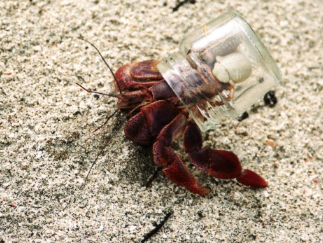
Is This a House for a Hermit Crab?

Overview
Students will use design thinking to build a house for a hermit crab or another animal.
Learning Objectives
Students will:
-
Understand design thinking
-
Understand empathy
-
Be able to have the knowledge of habitats design thinking to create a house for hermit crab or another animal.
Vocabulary
Vocabulary Words:
Design Thinking: Design thinking is a process for developing solutions to simple and complex problems.
Empathy: Empathy is to learn and understand; to be in their shoes.
Define: Define means to identify the issue/problem and solution based on needs and insight.
Inspiration: Inspiration is your why; source of interest, idea, question.
Ideate: To ideate/ create means to brainstorm and come up with creative ideas/solutions.
Prototype: Prototype is a representation of one or more of your ideas; draft or iteration.
Test: Test means to try your idea/solution for feedback; find out what worked and what didn't.
Refine: Refine means to fix and then go back to make changes (if necessary).
Science Vocab
Living things: Living things are things that are alive.
Non-living things: Non-living things are things that are not alive
Surroundings: surroundings are the things that are around where the animal or plant lives
Survival: Survival is the things that the plant or animal have to have to survive (food, water, shelter, and air)
Shelter: Shelter is the place that protects the animal when it sleeps or where lives (tree, cave, coral).
Habitat: A habitat is a place where an animal lives.
Science Concepts:
What do animals need to survive? food, air, water, shelter and the ability to adapt to environmental changes
What happens if an animal or plant's habitat changes and then cannot leave? It can adapt or if it does not adapt, it will die
Camouflage is when an animal is able to hide from its enemies by blending into its surroundings
What causes changes to habitats? Weather (season to season), fire and humans (pollution)
Pre-planning
To prepare for this lesson:
-
Some possible items needed:
- Cardboard
- Straws/ Strawbees
- Popsicle sticks
- Pipe cleaners
- Glue/scissors/markers/tape
- Yarn
- Construction paper
- Legos
- Pom poms
-
Watch video on Design Thinking.
-
The teacher may want to use the Design Thinking template.
-
Read, Is this a House For Hermit Crab. Story centers around hermit crab looking for a shell that fits him best.
-
Here is a video of the book being read with the illustrations.
-
-
Things to consider:
-
Time- this will take around 45 minutes -1 hour. If broken into stations, you could do this for a week.
-
Do you want students to work in pairs or groups of three? Groups past three students are not recommended.
-
Is this whole group or a station?
-
If it is a station, it is recommended that you explain design thinking and lesson as a whole before sending the students to the stations.
-
Will you assign an animal, or let students choose or have them design house for a hermit crab.
-
How do you want students to share out projects?
-
Flipgrid? SeeSaw? Present to class?
-
-
Accommodations
See the Accommodations Page and Charts on the 21things4students website in the Teacher Resources.
Steps
Directions for this activity:
- Play the video or read the story to the students:
- Discuss Design Thinking
- What is it?
- Talk about the Components of Design thinking.
- The teacher says to the students, "Today, we will be making a home for ____________"
-
Show Design Thinking template to the students if they are going to use it.
-
Go over the ideas with the students. A good rule of thumb is to create a design thinking example for students as you go.
-
Things to consider for animals: habitat, climate
-
Decide who you are creating a house for?
-
Decide what functions you want for the house.
-
Use the design thinking template if applicable
-
Assessment Options
Different options for assessing the students:
- Observations
- Check for understanding
- Students can reflect on the project using this document.
- Students can also share out on SEESAW, Google Classroom, Flipgrid or Schoology.
- Design thinking template
MITECS Competencies & ISTE STANDARDS
MITECS: Michigan adopted the "ISTE Standards for Students" called MITECS (Michigan Integrated Technology Competencies for Students) in 2018.
Innovative Designer
4a. Students know and use a deliberate design process for generating ideas, testing theories, creating innovative artifacts or solving authentic problems.
4c. Students develop, test and refine prototypes as part of a cyclical design process.
4d. Students exhibit a tolerance for ambiguity, perseverance and the capacity to work with open-ended problems.
Computational Thinker
5a. Students formulate problem definitions suited for technology-assisted methods such as data analysis, abstract models and algorithmic thinking in exploring and finding solutions.
5d. Students understand how automation works and use algorithmic thinking to develop a sequence of steps to create and test automated solutions.
Devices and Resources
Device: PC, Chromebook, Mac, iPad
Browser: Chrome, Safari, Firefox, Edge, ALL
App, Extension, or Add-on:
Websites:
Is This a House for Hermit Crabvideo
CONTENT AREA RESOURCES
ELA
- Reflect on Project document
- Story Mapping
Math
Talk about sequential order of story.
Science
Students learn about oceans/ habitats.
Social Studies
Students learn about water pollution.
CREDITS
This task card was created by Courtney Conley, Utica Public Schools. January 2020. Updated February 2025.


